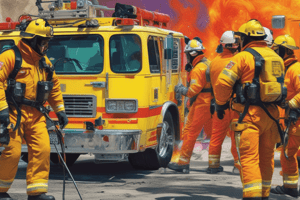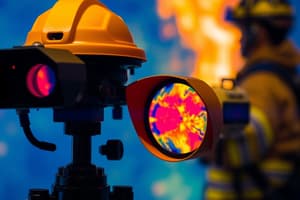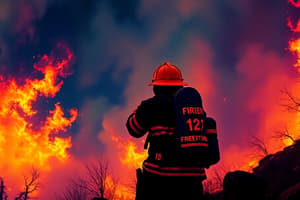Podcast
Questions and Answers
Where should the primary thermal imaging camera be stored during operation?
Where should the primary thermal imaging camera be stored during operation?
- In the back of the apparatus
- In a personal vehicle of the officer
- In the storage compartment of the apparatus
- In the officer's seat accessibility in the cab (correct)
What is one of the limitations of the thermal imaging camera?
What is one of the limitations of the thermal imaging camera?
- It is capable of seeing behind walls
- It can be affected by reflective surfaces (correct)
- It can function in extreme weather conditions
- It can provide a complete three-dimensional view
How often must the thermal imaging camera battery be changed?
How often must the thermal imaging camera battery be changed?
- Every morning (correct)
- Once a week
- Every evening
- Only if the camera is low on power
For which purpose is the thermal imaging camera NOT used?
For which purpose is the thermal imaging camera NOT used?
Who is responsible for ensuring the thermal imaging camera is deployed on dispatched structure fires?
Who is responsible for ensuring the thermal imaging camera is deployed on dispatched structure fires?
What should be done if the thermal imaging camera becomes damaged?
What should be done if the thermal imaging camera becomes damaged?
What is a recommended action to maintain the thermal imaging camera?
What is a recommended action to maintain the thermal imaging camera?
What is the primary goal of the operating guidelines for the thermal imaging camera?
What is the primary goal of the operating guidelines for the thermal imaging camera?
What primary use does the Thermal Imaging Camera (TIC) have during firefighting operations?
What primary use does the Thermal Imaging Camera (TIC) have during firefighting operations?
What is a significant limitation of the Thermal Imaging Camera?
What is a significant limitation of the Thermal Imaging Camera?
How should firefighters maintain the quality of the TIC's image?
How should firefighters maintain the quality of the TIC's image?
What should a firefighter do if the TIC becomes damaged or inoperative?
What should a firefighter do if the TIC becomes damaged or inoperative?
Why is it necessary to inspect the Thermal Imaging Camera daily?
Why is it necessary to inspect the Thermal Imaging Camera daily?
Which material can create a barrier for the TIC by displaying a reflective image?
Which material can create a barrier for the TIC by displaying a reflective image?
What visual indication does the TIC provide for heat sources?
What visual indication does the TIC provide for heat sources?
What is one method recommended over reliance on the TIC alone?
What is one method recommended over reliance on the TIC alone?
What is one purpose of the thermal imaging camera during firefighting operations?
What is one purpose of the thermal imaging camera during firefighting operations?
Which of the following best describes a limitation of the thermal imaging camera?
Which of the following best describes a limitation of the thermal imaging camera?
How should firefighting personnel maintain the thermal imaging camera to ensure its effective operation?
How should firefighting personnel maintain the thermal imaging camera to ensure its effective operation?
What should officers ensure regarding the deployment of thermal imaging cameras?
What should officers ensure regarding the deployment of thermal imaging cameras?
What should be done if a thermal imaging camera becomes inoperative?
What should be done if a thermal imaging camera becomes inoperative?
Which of the following statements illustrates the importance of familiarization with the thermal imaging camera?
Which of the following statements illustrates the importance of familiarization with the thermal imaging camera?
Why is it necessary to inspect the thermal imaging camera daily?
Why is it necessary to inspect the thermal imaging camera daily?
What type of visual perception does the thermal imaging camera provide?
What type of visual perception does the thermal imaging camera provide?
What should be the primary action if the Thermal Imaging Camera (TIC) is found to be damaged during inspection?
What should be the primary action if the Thermal Imaging Camera (TIC) is found to be damaged during inspection?
Which factor is NOT considered a limitation of the Thermal Imaging Camera (TIC)?
Which factor is NOT considered a limitation of the Thermal Imaging Camera (TIC)?
Why is it necessary to maintain a clean lens and screen on the Thermal Imaging Camera?
Why is it necessary to maintain a clean lens and screen on the Thermal Imaging Camera?
What is the recommended procedure when using the Thermal Imaging Camera in smoky conditions?
What is the recommended procedure when using the Thermal Imaging Camera in smoky conditions?
When should the battery of the Thermal Imaging Camera (TIC) be changed?
When should the battery of the Thermal Imaging Camera (TIC) be changed?
Which of the following is a visual indication of a heat source when using the Thermal Imaging Camera?
Which of the following is a visual indication of a heat source when using the Thermal Imaging Camera?
What action is recommended when using the TIC if there is soot buildup on the screen?
What action is recommended when using the TIC if there is soot buildup on the screen?
Which material can create a barrier for the Thermal Imaging Camera by displaying a reflective image?
Which material can create a barrier for the Thermal Imaging Camera by displaying a reflective image?
In what scenario should the thermal imaging camera be deployed according to the guidelines?
In what scenario should the thermal imaging camera be deployed according to the guidelines?
What feature of the thermal imaging camera limits its ability to detect heat sources?
What feature of the thermal imaging camera limits its ability to detect heat sources?
What type of maintenance is required daily for the thermal imaging camera?
What type of maintenance is required daily for the thermal imaging camera?
Which of the following describes a requirement for all personnel regarding the thermal imaging camera?
Which of the following describes a requirement for all personnel regarding the thermal imaging camera?
What action should be taken immediately if the thermal imaging camera is found to be inoperative?
What action should be taken immediately if the thermal imaging camera is found to be inoperative?
What should be a consideration when using the thermal imaging camera in various conditions?
What should be a consideration when using the thermal imaging camera in various conditions?
Which group is responsible for ensuring thermal imaging cameras are deployed during operations?
Which group is responsible for ensuring thermal imaging cameras are deployed during operations?
What is the intended purpose of the standard operating guidelines regarding thermal imaging cameras?
What is the intended purpose of the standard operating guidelines regarding thermal imaging cameras?
Which situation best illustrates when the use of a Thermal Imaging Camera (TIC) is critical for firefighter safety?
Which situation best illustrates when the use of a Thermal Imaging Camera (TIC) is critical for firefighter safety?
What specifically should firefighters avoid relying on excessively when using a Thermal Imaging Camera?
What specifically should firefighters avoid relying on excessively when using a Thermal Imaging Camera?
What condition on the thermal imaging screen indicates the presence of a heat source?
What condition on the thermal imaging screen indicates the presence of a heat source?
Which of the following is NOT a limitation of the Thermal Imaging Camera?
Which of the following is NOT a limitation of the Thermal Imaging Camera?
What is a key maintenance task for ensuring the effectiveness of a Thermal Imaging Camera?
What is a key maintenance task for ensuring the effectiveness of a Thermal Imaging Camera?
Which external factors can interfere with the functionality of a Thermal Imaging Camera?
Which external factors can interfere with the functionality of a Thermal Imaging Camera?
What is a recommended practice if a Thermal Imaging Camera becomes damaged during use?
What is a recommended practice if a Thermal Imaging Camera becomes damaged during use?
What action should firefighters take to maintain the clarity of the Thermal Imaging Camera's image?
What action should firefighters take to maintain the clarity of the Thermal Imaging Camera's image?
Study Notes
Standard Operating Line Summary
- Spring Fire Department (SFD) has a standard operating line (SOL) for thermal imaging cameras.
- SOL SFD.013 is for the use of thermal imaging cameras (TIC) by firefighters.
- The SOL was issued in August 2024, and it is subject to review annually.
- The purpose is to provide a consistent set of guidelines for the use of TICs owned by the department.
- All members of SFD must adhere to the policy.
Thermal Imaging Camera Usage
- Thermal imaging cameras are utilized on every dispatched structure fire and other identified situations to enhance the safety of firefighters during rescue operations.
- The TIC is also used for:
- Safer navigation in zero visibility spaces
- Search and rescue operations
- Fire attack and rapid intervention teams
- Locating fire during size-up
- Identifying structural compromise
- Locating hidden fires during overhaul operations
Thermal Imaging Camera Limitations
- The TIC provides a two-dimensional view, limiting depth perception.
- It cannot see through walls, but it can indicate a temperature increase behind a wall.
- The TIC can be affected by reflective surfaces like water, glass, and plastic, creating a barrier to the image.
- Holes in the floor might not appear on the screen as a temperature difference.
- The screen and lens need to be kept clean, as soot buildup decreases the quality of the image.
Thermal Imaging Camera Maintenance
- Each apparatus has assigned thermal imaging cameras.
- The primary TIC should be accessible from the officer's seat in the cab.
- All personnel must familiarize themselves with the unit before operating it in an emergency.
- TICs are inspected daily as part of the daily equipment checks.
- Batteries should be changed daily.
- If the TIC becomes damaged or inoperative, the on-duty District Chief should be contacted to obtain a replacement.
Storing and Maintaining Thermal Imaging Cameras
- TICs should be stored on the apparatus at all times.
- The TICs should have a clean lens and screen to ensure optimal viewing.
- If a TIC becomes damaged or inoperative, the current issue should be documented, and the on-duty District Chief should be contacted immediately.
- The District Chief will coordinate obtaining a replacement or loaner unit from logistics if available.
References and Related Policies
- The SOL references applicable laws, standards, and other related policies and guidelines.
- NFPA
- CPSE PI
- ISO
- TFCA
- Applicable State or Federal Statutes
- OSHA
- Spring FD
Contacts
- The point of contact for questions or comments on this SOL is:
- Company Officer
- District Chief
- Deputy Chief of Safety, Health, and Professional Development
- Assistant Chief
Thermal Imaging Camera Use
- The primary thermal imaging camera (TIC) is carried in the cab of the apparatus, accessible from the officer's seat.
- All personnel should familiarize themselves with the TIC before use in an emergency.
- The TIC is used on all dispatched structure fires and identified situations to enhance firefighter and rescue operations safety.
- The TIC can be used for navigation in low visibility areas, search and rescue, fire attack teams, rapid intervention teams, fire location during size-up, identifying structural compromise, and locating hidden fires during overhaul operations.
Limitations of the Thermal Imaging Camera
- The TIC only provides a two-dimensional view, lacking depth perception.
- It cannot see behind walls but will show temperature changes.
- Reflective surfaces like water, glass, and plastic can interfere with the TIC image.
- Holes in the floor might not appear due to temperature differences.
- Cool areas appear dark on the TIC, while heat sources appear white.
- The screen and lens must be kept clean to ensure optimal performance.
Storage and Maintenance of the Thermal Imaging Camera
- The TIC is stored on the apparatus at all times.
- Daily equipment checks include inspecting the TIC.
- The battery should be changed daily.
- The screen and lens require daily cleaning.
- If the TIC is damaged or inoperative, the issue should be documented and the on-duty District Chief should be contacted for a replacement or loaner unit.
Related Policies and Procedures
- Relevant policies and procedures include:
- National Fire Protection Association (NFPA) standards
- Certified Public Safety Equipment (CPSE) product information
- International Organization for Standardization (ISO) standards
- Texas Fire Chiefs Association (TFCA) guidelines
- Applicable state and federal statutes
- Occupational Safety and Health Administration (OSHA) regulations
- Spring Fire Department (SFD) internal policies
Thermal Imaging Camera Use
- The Spring Fire Department requires the use of a thermal imaging camera (TIC) on all dispatched structure fires and other identified situations requiring enhanced safety for firefighters or rescue operations.
- The TIC must be stored on the apparatus at all times, inspected daily, and have its battery replaced every morning.
- The TIC can be used for various purposes, including safer navigation in zero visibility spaces, search and rescue, fire attack teams, rapid intervention teams, locating fire during size-up, identifying structural compromise, and locating hidden fires during overhaul operations.
- The TIC is carried in the apparatus' cab with accessibility from the officer's seat.
- It's essential to familiarize oneself with the TIC before operating it in emergencies.
Limitations of the TIC
- The device offers a two-dimensional view, limiting depth perception in smoke-filled areas.
- It cannot see through walls.
- Water, glass, and plastic surfaces reflect light and could create a barrier to the device.
- Holes in the floor may not always appear on the screen due to lacking temperature differences.
Maintenance and Storage
- The TIC must be maintained with a clean lens and screen to ensure optimal viewing, as soot buildup could affect the image quality.
- If the TIC becomes damaged or inoperative, document the issue and immediately contact the on-duty District Chief.
- The District Chief will arrange for a replacement or loaner unit if possible.
Studying That Suits You
Use AI to generate personalized quizzes and flashcards to suit your learning preferences.
Related Documents
Description
This quiz focuses on the Standard Operating Line (SOL) SFD.013 for the use of thermal imaging cameras by the Spring Fire Department. It outlines the guidelines, usage, and limitations of thermal imaging cameras during firefighting operations, ensuring safety and efficiency. All SFD members are expected to adhere to these protocols.




